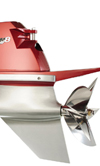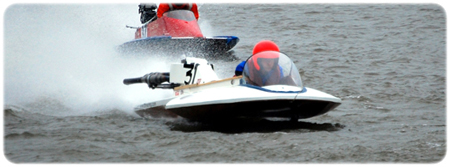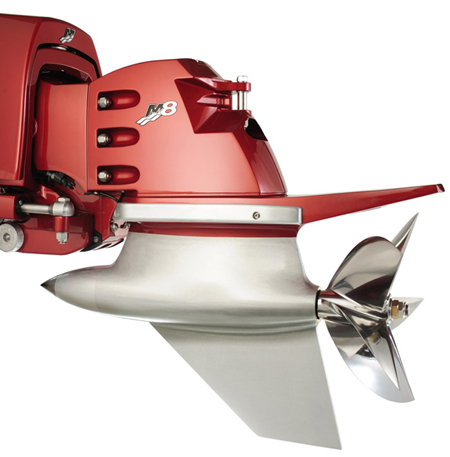High-speed raceboat propeller design
 Although attaining speeds up to and in excess of 100 mph on tarmac is not an arduous task, it is a rather more multi-faceted undertaking on water. One of the many considerations of high-speed marine applications is transmission and propeller design. There are a number of high-speed marine formulae that use various propulsion systems, including water-jet drives, super-cavitating and surface-piercing propeller drives.
Although attaining speeds up to and in excess of 100 mph on tarmac is not an arduous task, it is a rather more multi-faceted undertaking on water. One of the many considerations of high-speed marine applications is transmission and propeller design. There are a number of high-speed marine formulae that use various propulsion systems, including water-jet drives, super-cavitating and surface-piercing propeller drives.
The Oulton Broads and surrounding areas, in Suffolk,
England, have hosted hydroplane racing for many years. These high-speed vessels can reach speeds in excess of 50 knots (about 57 mph) using surface-piercing technology, most of them running two-stroke engines from manufacturers such as VRP, Rossi and Konig, the latter found in GP motorcycles ridden in the 1960s and '70s. Czech manufacturer Konny reproduces components for these classic Konig engines and transmissions. The technology has been used in high-speed applications for many years and, more recently, in Mercury Racing's M8 drive package where it aims to exploit the full potential of the 1350 hp 9 litre V8.
Conventional screw propellers are designed to operate fully immersed below the water's surface, but the nature of propeller design - and in fact any pump operating in water - can cause it to become exposed to cavitation conditions. The surface-piercing propeller drive offers reduced appendage drag over traditional stern drives and outboards, with the (possibly most critical) advantage that they do not suffer from the problems associated with cavitation. This alternative solution functions with the propeller semi-submerged, operating aerated, meaning it is not exposed to cavitation. You will instantly recognise a surface-piercing drive by its rooster tail and the separated sheets of wake caused by the propeller repeatedly entering and exiting the water's surface.

Unlike conventional propellers, surface-piercing drives operate with their low-pressure face completely aerated - there are a number of different phases of operation before the fully ventilated regime - that is, the face of the blade is completely covered with an air cavity. These propellers therefore rely on creating large amounts of lift from the positive pressure face due to loss of thrust on the suction side.
Numerous profiles have been explored to create maximum thrust in this ventilated condition. According to one theory, the most efficient foil shape offering the greatest lift:drag ratio has all its lift concentrated at its trailing edge. If you look closely at the trailing edge of some high-speed propellers you will notice heavy cupping, much like a Gurney Flap, which improves thrust by increasing the effective pitch of the propeller, and therefore supports this theory. Also, the distinctive trailing edge offers an attachment area for the air cavity, whilst helping to maintain blade strength and maximise blade area.

The propellers found on these high-speed vessels are easily recognised by their square trailing edge and thin leading edge, usually constructed from high-strength, corrosion- and fatigue-resistant stainless steels or nickel aluminium bronzes. Surface-piercing propellers, in particular, use these exotic materials due to the complex nature of the forces acting on a semi-submerged propeller. In addition to this, high-strength materials facilitate a smaller hub diameter, therefore reducing drag; they also permit the leading edge to be as thin as possible.
Having spoken to David Jones, who runs a 500 cc two-stroke Konig engine and surface-piercing drive in his classic hydroplane for the Area 31 Powerboat racing team based on the Oulton Broads, it seems that drivers have their own opinion and preference - drivers favour different transom heights, propeller diameters, pitches and the number of blades run on their raceboat. Area 31 runs a two-bladed propeller, while competitors run three-, four- and five-bladed items that are often hand-modified, offering different characteristics. It has also been found that excessive propeller diameter has caused chine walking on his raceboat.
Konny offers a number of different gear ratios for these engines, from 11:15 to 14:14 (1:1) depending on the course, propeller choice and running engine speeds of about 11,000-15'000 rpm, so propeller speeds are high. At these high speeds, therefore, cavitation would be unavoidable when operating fully submerged, yet propulsion with merely a quarter of the blade remains the most efficient method.
Fig. 1 - David Jones' A31 runs a three-bladed propeller
Fig. 2 - Mercury Racing's M8 drive exploits surface-piercing technology
Written by Chris Thwaites